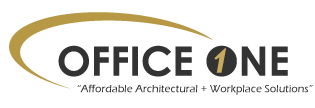Office One can provide your workplace with a raised access flooring solution that can assist you in achieving high energy savings and prepare you for future changes within your workplace such as additional technology or fire suppression advancements.

Raised Floors:
The two most common types of raised flooring are gravity held and lock down systems. Gravity held raised flooring systems (a.k.a. loose lay) are systems in which the floor panels rest on the pedestal head. The panels are held in place by their own weight with lateral location providing engagement between panel and pedestal head. These systems allow very quick and easy access to the floor void and the panels can be readily finished with factory bonded finishes.
Lock down or screw down products are the second type. In this case the floor panel is screwed or locked directly to the pedestal head thereby holding the panel in place and also providing lateral location. This system provides a very solid and rock free floor with quick and easy access to the floor void. However these systems cannot accept factory bonded finishes.
Low profile raised flooring is also a good option for retrofits, or any building where there is low ceiling space.
Raised access floors are used to provide the following benefits:
- Easy maintenance – Quick access to power, data and telecom services found within today’s buildings
- The underfloor space or cavity is often used as a large duct for HVAC systems
- Adaptability / flexibility for the needs of incoming occupants
- Can serve as easy insulation layer with proper treatment
- Is adjustable to uneven floors
- Can provide immense energy savings and boost efficiency
- Fire suppression
- Easy installation and dissembling
- Quiet and solid feel underfoot
Some common workplace applications for raised access floors:
- Financial and Insurance offices
- General administration buildings
- Call Centers
- Data processing centers
- Telecom switch centers
- Distribution centers
- Educational facilities
- Retail facilities and major department stores
- Electronic and Pharmeceutical industries requiring clean room facilities



















